代写论文的来生:企业作者如何塑造了二十年的草甘膦安全论述
IF 5.2
2区 环境科学与生态学
Q1 ENVIRONMENTAL SCIENCES
引用次数: 0
摘要
公司代写是一种科学欺诈:一篇论文被虚假地呈现为其他人的作品,而不是其实际作者。当这些论文传播时,它们破坏了全部或部分基于这些研究的科学研究和政策决策的完整性。本文考察了发表在《管制毒理学与药理学》上的一项代写研究Williams, Kroes, and Munro (2000) (WKM2000)的影响。这篇论文是由孟山都公司精心制作的,旨在支持草甘膦安全性的说法,草甘膦是农达的活性成分。尽管在孟山都论文中发现了它的代笔性质,但这篇论文并没有被撤回,而是继续被引用。使用案例研究方法,我们跟踪了WKM2000在三个领域的影响。我们发现WKM2000在过去二十年中发挥了相当大的影响,塑造了公众理解、科学话语和政策决策。维基百科经常引用WKM2000来支持草甘膦的安全性;试图将其代写的起源置于背景下的尝试一再被推翻或删除,这说明了企业赞助的科学如何渗透到公共知识平台。对引用WKM2000的政策和治理文件的分析显示,绝大多数引用它时不加批判。在学术文献中,WKM2000在讨论草甘膦的论文中被引用次数排名前0.1% %,表明草甘膦被广泛使用,并且很少承认利益冲突。我们的发现强调需要更严格的期刊政策来筛选和撤回代写论文,以维护科学诚信,以及公共健康和安全。本文章由计算机程序翻译,如有差异,请以英文原文为准。
The afterlife of a ghost-written paper: How corporate authorship shaped two decades of glyphosate safety discourse
Corporate ghost-writing is a form of scientific fraud: a paper is falsely presented as the work of people other than its actual authors. When such papers circulate, they undermine the integrity of scientific research and policy decisions based wholly or in part on that research. This paper examines the impact of a single ghost-written study, Williams, Kroes, and Munro (2000) (WKM2000), published in Regulatory Toxicology and Pharmacology. The paper was crafted by Monsanto to support claims of the safety of glyphosate, the active ingredient in Roundup. Despite revelations of its ghostwritten nature in the Monsanto Papers, the paper has not been retracted and continues to be cited. Using a case study approach, we trace the impact of WKM2000 across three domains. We find that WKM2000 has exerted considerable influence over two decades, shaping public understanding, scientific discourse, and policy decisions. WKM2000 has been frequently cited on Wikipedia to support the safety of glyphosate; attempts to contextualize its ghostwritten origins have been repeatedly reversed or removed, illustrating how corporate-sponsored science infiltrates public knowledge platforms. An analysis of policy and governance documents citing WKM2000 revealed that the vast majority referenced it uncritically. In academic literature, WKM2000 is in the top 0.1 % by citation count among papers discussing glyphosate, indicating broad uptake, with minimal acknowledgment of conflict of interest. Our findings underscore the need for stricter journal policies to screen and retract ghostwritten papers, in order to safeguard science integrity, as well as public health and safety.
求助全文
通过发布文献求助,成功后即可免费获取论文全文。
去求助
来源期刊

Environmental Science & Policy
环境科学-环境科学
CiteScore
10.90
自引率
8.30%
发文量
332
审稿时长
68 days
期刊介绍:
Environmental Science & Policy promotes communication among government, business and industry, academia, and non-governmental organisations who are instrumental in the solution of environmental problems. It also seeks to advance interdisciplinary research of policy relevance on environmental issues such as climate change, biodiversity, environmental pollution and wastes, renewable and non-renewable natural resources, sustainability, and the interactions among these issues. The journal emphasises the linkages between these environmental issues and social and economic issues such as production, transport, consumption, growth, demographic changes, well-being, and health. However, the subject coverage will not be restricted to these issues and the introduction of new dimensions will be encouraged.
 求助内容:
求助内容: 应助结果提醒方式:
应助结果提醒方式:


